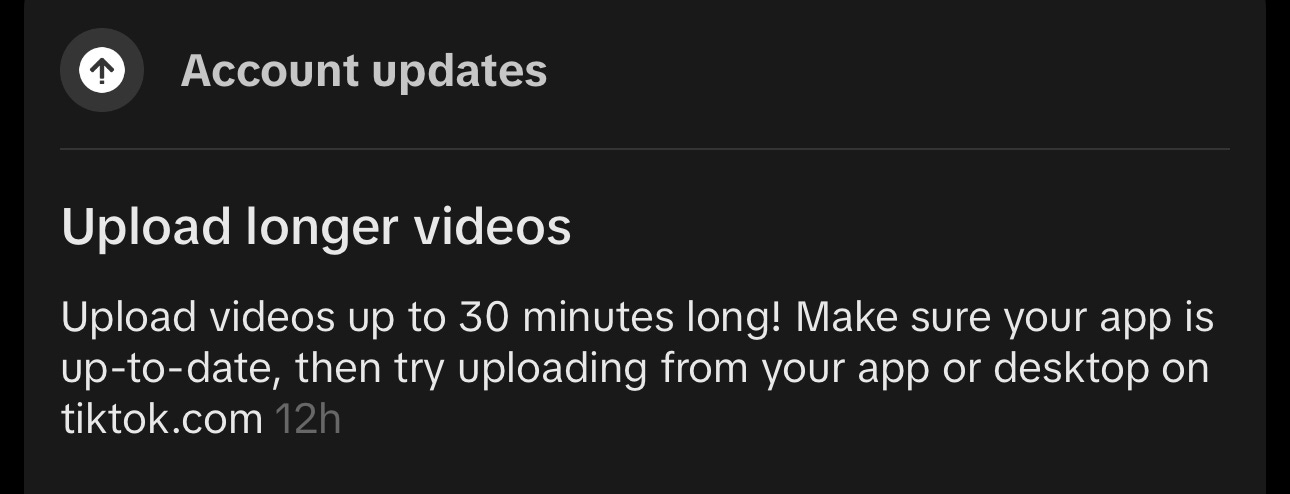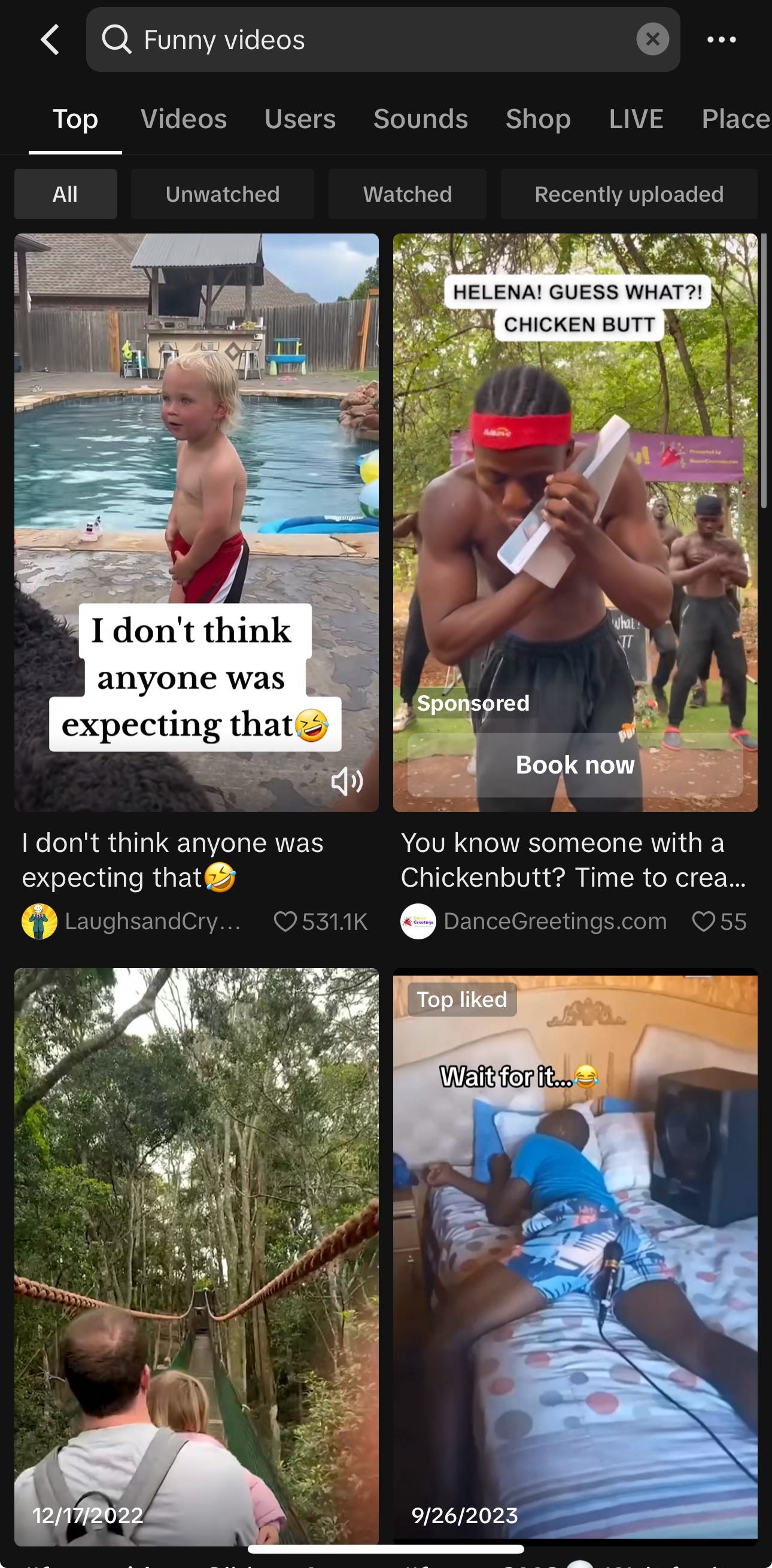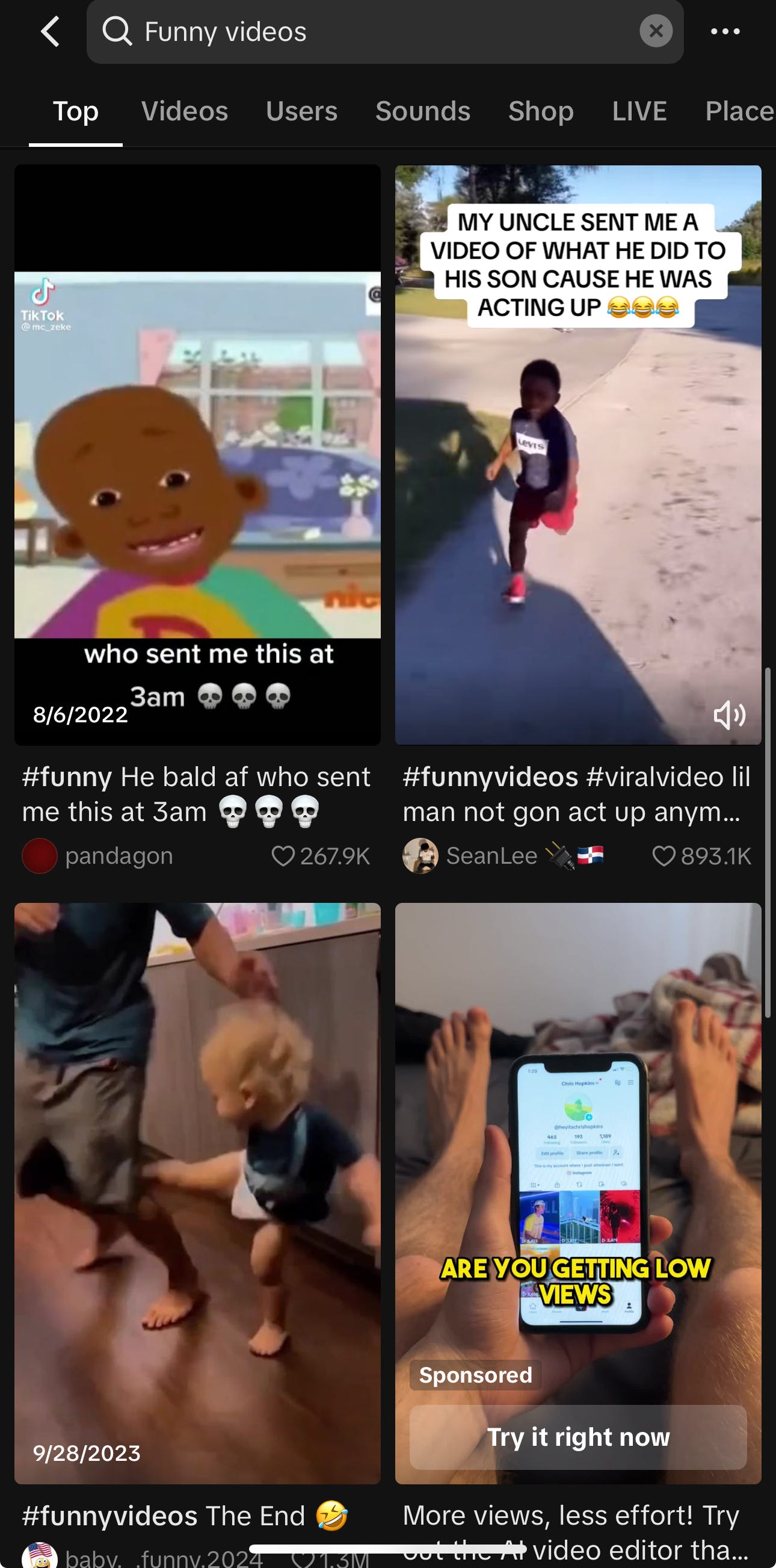Did TikTok Just Give Away Their Algorithm?
What allowing 30 minute videos means for the platform's future.
Hi all,
Popping in to share this notification I received within the TikTok app last week:
On a related note, the Creativity Program Beta finally exited its Beta and is now called the “Creator Rewards Program”, which financially incentivizes top creators to make videos longer than 1 minute.
According to some guy’s blog, the average length of the Top 100 TikToks in 2019 was just 15.6 seconds.
Rest assured, that will not be the case in 2024.
In fact, you could supercut all 100 of the Top 100 TikToks from 2019 into a single TikTok in 2024, and still have 4 minutes to spare!
So what is the Creator Rewards Program, and how does it work?
Per TikTok itself, in order to collect rewards under the new Creator Rewards Program, videos must meet the following requirements:
• Must be original and high-quality content that is filmed, designed, and produced entirely by yourself.
• Be at least one minute long.
• Uploaded after joining the Creator Rewards Program.
• Have at least 1,000 qualified For You feed views.
༚ Video views from the same account will be calculated only once for one video.
༚ Video views must be longer than 5 seconds.
༚ Views on videos that are reported by others as Not interested aren't counted.
• Doesn't include advertisements, disinformation or misleading information, paid promotions, sponsored content, or videos linked to a Series.
• Adheres to our Community Guidelines, Terms of Service, and Copyright Policy.
Of course, this begs the question:
How are rewards calculated in the Creator Rewards Program?
Your eligible videos start to collect rewards as soon as they reach 1,000 qualified For You feed views. We calculate rewards based on the following conditions:
• Qualified views: The legitimate views for your eligible videos that comply with the Creator Rewards Program terms (see terms for Brazil, France, Germany, Japan, South Korea, the U.K., and the U.S). Qualified views are unique video views from the For You feed and excludes fraudulent views, paid views, disliked views, views with less than 5 seconds watched, promoted views, and artificial views.
• RPM: The average rewards collected per 1,000 qualified views. RPM considers many factors, including:
༚ Video performance (your videos' average watch time and finish rates)
༚ Search value (the amount of search traffic that your content generates, including video views on the search page)
༚ Location (the region where you're based and where your video is viewed)
༚ Video engagement (the amount of viewers that engage with your content)
༚ Advertising value (your viewer's ad watch time on TikTok)
To increase your RPM, focus on producing high-quality, original, and engaging content that considers the program's key factors. Keep in mind that once you receive approval to join the Creator Rewards Program, only eligible videos that are posted after you're approved can collect rewards.
What jumps out?
For me, it’s the factors that influence RPM. Video performance, location, and engagement were expected (and I actually already incorporate all three on client audits), but I wanted to emphasize the other two: search value and advertising value.
To do so, I encourage you to open TikTok and enter something in the search bar.
For example, I’m going to search “Funny videos”.
Here’s the first 8 results that show up for me:
Do you notice what I notice?
2 of the 8 videos (or 25% of the search results) are subtly classified as “Sponsored”.
They’re ads!!! Or have some paid spend behind them via Promote Assistant.
And the videos surrounding these ads were deemed to have high “search value”.
Really think about why these are the factors directly impacting the payouts of the Creator Rewards Program, and how all of this plays into TikTok’s overarching, not-so-subtle desire to push longer videos.
What does this tell you about the direction of the platform?
Take a look at the overall social media landscape, and how they all stack up.
Do you notice who is copying who, and when?
How Facebook ate Snapchat's lunch by stealing their “Stories” concept, and then suddenly every other app added stories? (LinkedIn Stories and Fleets, anyone??)
How TikTok now has a "Friends" push, and after every tenth video, they're trying to get you to add “People You May Know" from your contacts?
How X (Twitter) now has a For You feed that they funnel you towards by default, instead of your desired “Following” feed?
How Instagram added Reels, a resounding success, and Threads, a total flop?
How TikTok Shop, their recent e-commerce play, became its own browsing option in addition to Following, Friends, For You, and STEM1?
Or how TikTok started out with one minute videos, but then expanded to 3, and then 10, and then 15, and now 30 minute videos?
How YouTube gets a clock radio, but TikTok can not afford?
So what does all of this mean?
When these platforms show you who they are, believe them.
In order to grow on them organically, you have to understand the wider context of the ecosystem you are entering.
If you are a comedian, remember that you are not posting your videos to ComedyCentral+, an app filled with rabid Carlin fans and Mulaney-heads.
You are attempting to leverage a free-to-use global platform with over a billion monthly active users as a means of – let's face it – self-promotion.
Before posting anything at all, ask yourself these questions:
Why are these platforms free-to-use?
If they are “free-to use”, how do these platforms make money?
How do they ensure the free content fed to their millions of users aligns with their overall goals at scale? (making more $$)
Your goal is to grow your audience, and sell more tickets, or Doritos, or shoes via organic social media posts2, but what are their goals?
(Hint: making more $$)
With so many new posts per day, how do they standardize the content moderation process, ensuring customer, advertiser, and shareholder satisfaction?
For instance, do they incorporate a series of metrics to boost / remove certain content? (what is colloquially known as "the algorithm")
How should all of this inform my content strategy?
Let's address these questions one by one.
How do these platforms make money?
The two main ways 90% of the apps on your phone make money are via a recurring monthly subscription (Netflix, New York Times) or advertisements (Google Chrome, Candy Crush).
Most apps offer a "free" (ad-based) version as an eventual funnel to the subscription tier (Uber > Uber One, Spotify > Spotify Premium, Hinge > Hinge+).
Social media apps are no different.
Leave this post for a second and scroll through your Instagram Home tab / Story feed for a minute.
No, seriously. Go do it.
How many pieces of content were "Sponsored" ads from accounts you don't follow?
Every single one of those was paid for.
These ad slots are the "products" that social media apps sell to advertisers.
To the user, social media apps are primarily entertainment platforms, and a means of communication / connection with others.
To advertisers, they serve as commercial booking agencies.
Only instead of Flo from Progressive, you're getting hyper-personalized ads based on your demographic information, location, and categories of pages you follow.
Remember when you liked 500 Facebook pages in 2011 for some reason? Of every band and TV show you've ever heard of, and pages like, "THE DRUM FILL FROM IN THE AIR TONIGHT BY PHIL COLLINS"? (Just me?)
Consider that Meta (who not only owns Facebook and Instagram, but WhatsApp, Oculus, and probably one more thing I'm forgetting) has access to all of that data.
Same goes for your YouTube and Google search data.
Consider that every fourth video on your TikTok FYP or your Instagram Home Feed is an ad. Sometimes Instagram will even go back-to-back with sponsored posts.
They’re all competing with one another for your attention, stealing each other's best features and functionality to become your chief app that you watch the most ads on.
Why are these platforms free-to-use?
Because they make a shit ton of money from advertisers!!
Hopefully you know this, at least intuitively. Perhaps you've considered how for-profit search engines like Amazon and Google operate. How being in the top results for every keyword search is wagered on in an auction-style bidding war, as if it's an Orange-colored Monopoly property. How even in the non-sponsored section, it's all still determined by SEO, domain authority, keyword relevancy, and so on.
How these platforms can afford to pay their employees such high wages because they're rinsing small businesses and corporations alike with biweekly changes to the factors determining search engine ranking (cut to every business owner, nodding).
How the results of these services are controlled by some foggy SEO guidelines, and an even foggier “Discover” or “For You” infinite scroll.
How do they ensure the content fed to their users aligns with their overall goals at scale (making more $$) and how do they standardize the process of content moderation? Is there some sort of “algorithm”?
Here is where there seems to be a disconnect between creators and the platforms they post on.
The creators, platforms, and advertisers all want the same thing: great, entertaining content that gets seen and engaged with by millions of other users.
The only difference is why each party wants this to happen.
With the recent pushes for TikTok Shop and the Creator Rewards Program, TikTok is barely attempting to hide its intentions.
They want creators to be salespeople, either by directly peddling products as a TikTok Shop affiliate, or by creating content so great / engaging / viral, that your account gets labeled as having high “search value” and “advertiser value”.
Scroll, scroll, TikTok shop video. Add to cart. One-click purchase. Back to the FYP.
Scroll, shop, sleep, repeat.
Any (non-paid) away funnels are discouraged.
Away-funnel keywords like "YouTube", or "link in bio" get flagged by the content moderation team and suppress view counts (cut to doznes of my clients, nodding).
This isn't some unfounded conspiracy theory, I can point to specific posts where I've encountered this.
Re: “the algorithm”
Many people seem to think of the algorithm as if it's some combination of the quadratic formula and an eight-headed serpent deity that you must appeal at all times.
A series of measurable inputs where, if the perceived value is above some numerical threshold, the video obtains a value judgment of "BOOST", and goes to the moon.
I have no idea if that's correct.
What I can tell you is, they want you to post viral videos just as much as you do!
This is not some secret insider information.
All of these platforms give you heaps of audience insights. They tell you when your followers are most active, what cities they're located in, their average watch time, etc.
They are telling you in thinly-veiled, coded language / metrics what gets valued on their end, so that you can make content that generates them more ad revenue.
Let’s take another look at those RPM factors for the Creator Rewards Program:
RPM (the average rewards collected per 1,000 qualified views) considers many factors, including:
༚ Video performance (your videos' average watch time and finish rates)
༚ Search value (the amount of search traffic that your content generates, including video views on the search page)
༚ Location (the region where you're based and where your video is viewed)
༚ Video engagement (the amount of viewers that engage with your content)
༚ Advertising value (your viewer's ad watch time on TikTok)
To increase your RPM, focus on producing high-quality, original, and engaging content that considers the program's key factors.
That’s the algorithm.
Don’t listen to anyone who tells you differently.
Another thing I can tell you, is that you can "feel” when you have a video on the FYP.
And I mean that haptically.
When you hit that 99+ in your notification inbox, and every time you refresh the app, the video has hundreds more views, it feels really freaking good.
Now, TikTok is directly incentivizing its best creators to constantly chase that feeling.
By the way, I don't blame them! If I'm the CRO of one of these companies, I want as many as people as possible to be watching videos on my platform. Period.
Not watching the extended version of these clips on the creator’s Patreon. Not listening to their full podcast on Spotify. Not going to their live show – unless, of course, they’ve set up a paid ad campaign to promote it. Then, by all means, go ahead.
Because the more time these users spend on my platform, the more money I make.
So how should all of this inform my content strategy?
Well if I’m an entertainment venture in any capacity, I would start posting longer clips immediately.
When I audited all of Matt Rife’s TikTok posts from 2022-2023, I thought this chart was the biggest takeaway:
Longer, longer, longer.
If I'm SNL, or @midnight, or Jeopardy, or Fallon, or a DTC podcast, I'm posting full-length sketches, entire interviews, maybe even full episodes, onto TikTok.
By ensuring your output supports these platform’s larger goals (making more $$), you have a much better shot of achieving your own.
David Zucker is a digital marketing consultant based in New York City. A former analyst at TikTok, his unique, data-driven approach has catapulted the growth of his clients’ audiences all over the world. He also happens to have oculocutaneous albinism, a rare genetic disorder which renders him legally blind. This condition offers him a unique perspective on both live and digital comedy, especially with respect to accessibility. To schedule a consult, click here.
Which they only added last year after genuinely attempting to claim they are an educational platform, and not a digital vending machine filled with junk food and softcore porn.
(as opposed to paid)






